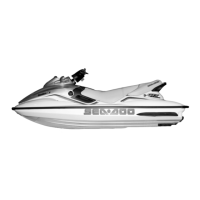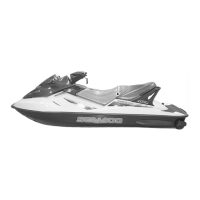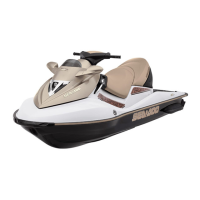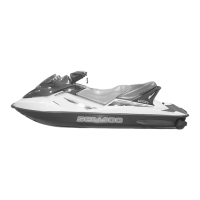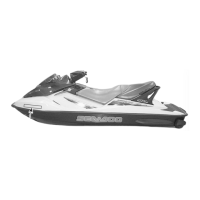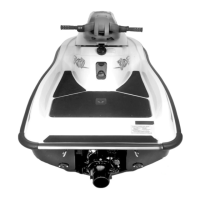Why Sea-doo Boat engine continually backfires?
- CChristopher EllisSep 23, 2025
If your Sea-doo Boat engine continually backfires, it could be due to a weak spark. Try to clean or replace. Also, check and reset the ignition timing.
Why Sea-doo Boat engine continually backfires?
If your Sea-doo Boat engine continually backfires, it could be due to a weak spark. Try to clean or replace. Also, check and reset the ignition timing.
What to do if Sea-doo Boat can not reach top speed?
If your Sea-doo Boat can't reach top speed, it could be due to a clogged jet pump water intake, a damaged impeller, a safety lanyard that limits speed, or the monitoring system putting the watercraft in limp home mode. Clean the jet pump water intake and check for damage. Replace a damaged impeller. Use a safety lanyard that allows reaching the top speed. Release the throttle so that the engine returns to idle speed.
Why Sea-doo Boat engine will not start?
If the engine of your Sea-doo Boat won't start, it could be due to several reasons related to the engine not turning over. If you do not hear 2 short beeps when installing safety lanyard, it is recommended to refer to the DIGITALLY ENCODED SECURITY SYSTEM. Other solutions include checking the wiring, solenoid, and MPEM, or checking and replacing fuses. Also, check, clean, and tighten connections, or check and recharge the system.
What to do if Sea-doo Boat engine turns normally?
If the Sea-doo Boat engine turns normally but doesn't start, the fuel tank valve might be closed, the fuel tank could be empty or water-contaminated, the fuel filter might be clogged, the spark plugs could be fouled, the choke might be misused, the engine could be fuel-flooded, there could be a faulty component in the fuel injection system, a burnt fuel pump fuse, or an electrical problem. Turn the fuel tank valve to the ON position. Refill the fuel tank, siphoning out any old fuel and replacing it with fresh fuel. Clean the fuel filter and check the tank for water. Replace the spark plugs.
What to do if Sea-doo Boat engine turns slowly?
If the Sea-doo Boat engine turns slowly, it might be due to loose battery cable connections, a discharged or weak battery, or a worn starter. Check, clean, and tighten the battery cable connections.
How to fix no spark at spark plugs in Sea-doo Boat?
If there is no spark at the spark plugs in your Sea-doo Boat, it could be due to a faulty rev limiter. In this case, replace the MPEM. Alternatively, a faulty ignition module may be the cause, requiring replacement of the MPEM or ignition module, depending on the model.
What to do if Sea-doo Boat engine misfires, runs irregularly?
If your Sea-doo Boat engine misfires and runs irregularly, consider the possibility of a lean fuel mixture and a dry spark plug. You should check and refill fuel, and inspect the pump, regulator, injectors, and hose pinchers, replacing them if necessary. Other steps include checking, cleaning, and replacing the fuel filter, removing and cleaning the injectors, and pressure checking the engine. Also, make sure you check and siphon and refill, or check and replace fuel.
How to fix Sea-doo Boat engine misfires with fouled spark plug?
If your Sea-doo Boat engine misfires and you find a fouled spark plug indicating a rich fuel mixture, begin by checking and adjusting the choke cable. You may also need to check and replace the spark plug. Additionally, inspect the pump, regulator, injectors, and hose pinchers, replacing them if necessary.
Why Sea-doo Boat has weak spark?
If the Sea-doo Boat has a weak spark, it could be due to fouled, defective, or worn spark plugs, or too much oil supplied to the engine. Replace the spark plugs.
Why Sea-doo Boat engine cannot run above idle speed?
The Sea-doo Boat engine may not run above idle speed because the monitoring system put the watercraft in limp home mode due to a component malfunction. Try removing and reinstalling the safety lanyard on its post.
Provides essential rules and precautions for safe watercraft operation.
Details on how to operate the watercraft safely, including passenger safety.
Details the duration of the warranty for different usage types.
Explains the manufacturer's responsibilities for repairs under warranty.
Outlines the customer's obligations for warranty service validation.
Lists conditions and damages not covered by the limited warranty.
Details the duration of the warranty for different usage types globally.
Explains manufacturer's responsibilities for repairs under international warranty.
Outlines customer obligations for international warranty service validation.
Lists conditions and damages not covered by the international limited warranty.
Location and composition of the Hull Identification Number.
Details on locating the Engine Identification Number for various engine types.
Explanation of safety lanyard, DESS, and engine start/stop button functions.
How to use the handlebar and throttle lever for watercraft control.
Description of fuel gauge, speedometer, tachometer, and info center.
Details on fuel tank valve, cap, and oil injection reservoir.
Information on eyelets, cleats, boarding aids, cooling, and jet pump.
Covers the location and function of fuses and the battery.
Step-by-step guide for safe and proper watercraft fueling.
Specifies the correct types of fuel and oil for the watercraft.
Recommended inspection after the initial 10 hours of operation.
Explains the basic propulsion mechanism of the watercraft.
Detailed steps for safely starting the watercraft engine.
Guidance on riding, crossing waves, and handling different conditions.
Instructions on how to slow down, stop, and dock the watercraft.
Methods for safely boarding the watercraft from docks or deep water.
Steps for daily cleaning, draining water, and flushing the cooling system.
Methods to protect metallic components from corrosion.
Troubleshooting steps for engine overheating and cleaning the intake.
Procedures for dealing with engines affected by water or fuel flooding.
Guidance on towing the watercraft and addressing low-charge battery conditions.
Details on manufacturer and dealer responsibilities for emission systems.
Instructions for lubricating various moving parts and components.
A schedule for regular checks and servicing of the watercraft.
Guidelines and safety precautions for towing the watercraft.
Steps for preparing and storing the watercraft for the off-season.
Instructions for getting the watercraft ready for use after storage.
Interpreting beeper signals to diagnose system issues.
Common causes and remedies for the engine not starting.
Diagnosing and resolving issues like misfires, overheating, and low power.
| Manufacturer | Sea-Doo |
|---|---|
| Model | GTX RFI |
| Category | Personal Watercraft |
| Engine Type | 2-Stroke |
| Fuel System | RFI (Rotax Fuel Injection) |
| Seating Capacity | 3 |
| Oil Capacity | 3.2 quarts |
